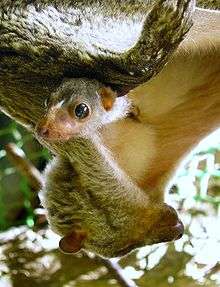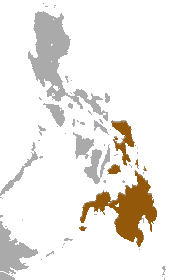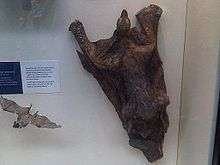Philippine flying lemur
| Philippine flying lemur | |
|---|---|
 | |
| Scientific classification | |
| Kingdom: | Animalia |
| Phylum: | Chordata |
| Class: | Mammalia |
| Order: | Dermoptera |
| Family: | Cynocephalidae |
| Genus: | Cynocephalus Boddaert, 1768 |
| Species: | C. volans |
| Binomial name | |
| Cynocephalus volans (Linnaeus, 1758) [2] | |
 | |
| Philippine flying lemur range | |
The Philippine flying lemur or Philippine colugo (Cynocephalus volans), known locally as the kagwang, is one of two species of flying lemurs, the only two living species in the order Dermoptera.[3] Additionally, it is the only member of the genus Cynocephalus. The other species is the Sunda flying lemur. Recent research from genetic analysis suggests two other species, the Bornean flying lemur and the Javan flying lemur, may exist, as well, but they have yet to be officially classified so. Although called a flying lemur, it cannot fly and is not a lemur. Both species of Dermoptera are classified under the superorder Euarchonta which includes the Scandentia and the primates, as well as an extinct order of mammals, the Plesiadapiformes.[4]
Habitat
The Philippine flying lemur is endemic to the southern Philippines.[5] Its population is concentrated in the Mindanao region and Bohol. Colugos live in heavily forested areas, living mainly high up in the trees in lowland and mountainous forests or sometimes in coconut and rubber plantations, rarely coming down to the ground.[5] The types of forests they inhabit are mainly primary and secondary forests.[6]
Physical features

An average Philippine flying lemur weighs about 1.0 to 1.7 kg (2.2 to 3.7 lb) and its head-body length is 33–38 cm (13-15 inch). Its tail length is 17–27 cm (6.7-10.6 inch).[7] The species does exhibit sexual dimorphism where females are a bit larger than males. It has a wide head and rostrum with a robust mandible for increased bite strength, small ears, and big eyes with unique photoreceptor adaptations adapted for its nocturnal lifestyle. The large eyes allow for excellent vision which the colugo uses to accurately jump and glide from tree to tree.[8] It has an avascular retina which is not typical of mammals, suggesting this is a primitive trait; on par with other nocturnal mammals, specifically nocturnal primates, the rod cells in the eye make up about 95-99% of the photoreceptors and cones make up about 1-5%.[4] Its clawed feet are large and sharp with an incredible grip strength, allowing them to skillfully but slowly climb trees, hang from branches, or anchor themselves to the trunk of a tree.[8] One unique feature of the colugo is the patagium, the weblike membrane that connects its limbs to allow for gliding. Unlike other mammals with patagia, its patagium extends from the neck to the limbs, in between digits, and even behind the hind limbs and the tail. Its keeled sternum, which is also seen in bats, aids in its gliding efficiency.[5] Its patagium is the most extensive membrane used for gliding in mammals and also functions as a hammock-like pouch for its young. This membrane helps it glide distances of 100 m or more, useful for finding food and escaping predators, such as the Philippine eagle (Pithecophaga jefferyi) and tree-climbing snakes that try to attack the colugos when they glide between trees.[9][10] The dental formula of Philippine flying lemur is 2/3, 1/1, 2/2, 3/3, with a total of 34 teeth. The first two lower procumbant incisors are pectinate with up to 15 tines which are thought to be used for grooming and grating food.[5] The upper incisors are small and have spaces between them, as well.[5] The deciduous teeth are serrated until they are lost and then they are replaced with blade-like teeth, designed to shear along with the molars that also have long shearing crests to help break down the plant matter they ingest.[11] Following mechanical digestion, the digestive tract of the Philippine flying lemur, especially the stomach, is specially adapted to break down and process the large amount of leaves and vegetation they ingest.[8] Colugos also have a brownish grey-and-white pelage they use as camouflage amongst the tree trunks and branches, which allows them to better hide from predators and hunters.[5]
Diet
The Philippine flying lemur is a folivore, eating mainly young leaves and occasionally soft fruits, flowers, and plant shoots. They also obtain a significant amount of their water from licking wet leaves and from the water in the plants and fruits themselves.[8] Most of their nutrition is obtained from jumping and gliding between trees high in the canopy; rarely do they eat on the forest floor.
Behavior
The Philippine flying lemur is arboreal and nocturnal and usually resides in primary and secondary forests. However, some wander into coconut, banana, and rubber plantations as deforestation for farming and industry is an increasingly prevalent problem. The colugo sleeps in hollow trees or clings onto branches in dense foliage during daytime.[10] When they engage in this hanging behavior from branches, they keep their heads upright, unlike bats.[5] On the ground, colugos are slow and clumsy, and not able to stand erect, so they rarely leave the canopy level of the forest where they glide from tree to tree to get to food or their nests which are also high in the trees. In the trees, though, colugos are quite effective climbers, though they are slow; they move in a series of lingering hops as they use their claws to move up the tree trunk.[8] Foraging only at night, colugos on average forage for 9.4 minutes about 12 times per night.[5] They typically leave their nests at dusk to begin their foraging activity.[6] When foraging, returning to the nest, or just moving around, the Philippine flying lemur uses its patagium to glide from tree to tree. The patagium is also used for cloaking the colugo when it is clinging to a tree trunk or branch, and sometimes it is even seen curled up in a ball, using its patagium again as a cloaking mechanism among palm fronds often in coconut plantations.[8]

Colugos maintain height in the trees to avoid predators that may live in lower levels, but they are still susceptible to other predators that can reach these higher levels of the canopy and predatory birds that can attack from above. They live alone, but several may be seen in the same tree where they maintain their distance from one another and are very territorial of their personal areas.[10] Though they are not social mammals, they do engage in a unique semisocial behavior where colugos living in the same relative area or tree follow each other's gliding paths through the trees in search of food.[10] This may be a defense mechanism where, as a population, the safest route possible is determined and shared as a sort of cooperative mechanism for increased survival rates. The only time colugos actually live socially is after a mother has given birth; then she will care for and live with her offspring until they are weaned; at that point, the offspring is on its own.[10] The average lifespan of the Philippine flying lemur is unknown.
Reproduction
Little is known about the reproductive behavior in colugos. The female Philippine flying lemur usually gives birth to one young after a two-month gestation period.[6] The young is born undeveloped and helpless and it attaches itself to its mother's belly, in a pouch formed from the mother's tail membrane. They are eventually weaned around 6 months old, and they leave their mother's patagium.[6] Adult size and sexual maturity is reached between two and three years of age.[8] Mating usually occurs between January and March.[10]
Conservation

Due to the phylogenetic, morphological, and ecological uniqueness of the order Dermoptera, conservation efforts in respect to this species are highly important and must be reassessed and continued, especially due to the recent discoveries of the potential new Bornean and Javan species that are genetically and morphologically different.[12] The IUCN 1996 had declared the species vulnerable owing to the destruction of lowland forests and to hunting, but it was downlisted to Least Concern in 2008. The 2008 IUCN report indicates the species persists in the face of degraded habitat, with its current population large enough to avoid the threatened category.[1] Since colugos have limited dispersal abilities, they are increasingly vulnerable as deforestation is occurring at increasing rates.[12] Other threats to the species include hunting by the farmers of the plantations they sometimes invade, where they are considered pests, since they eat fruits and flowers. In local cultures, their flesh is also consumed as a delicacy; other uses of the colugo vary in different regions of the Philippines. In Bohol, their fur is used as material for native hats, but in Samar, the species is considered a bad omen and is killed either to be used as a warning or to get rid of the omen.[1] The animal is largely unknown in many areas in the Philippines that on Facebook its photo was once mistaken for a supernatural creature which was said to feed on other animals, even though in reality the endangered species is a folivore that feeds on fruits, flowers and leaves.[13]
References
- 1 2 3 Gonzalez, J.C.; Custodio, C.; Carino, P.; Pamaong-Jose, R. (2008). "Cynocephalus volans". IUCN Red List of Threatened Species. IUCN. 2008: e.T6081A12410826. doi:10.2305/IUCN.UK.2008.RLTS.T6081A12410826.en. Retrieved 24 November 2016.
- ↑ Linnæus, Carl (1758). Systema naturæ per regna tria naturæ, secundum classes, ordines, genera, species, cum characteribus, differentiis, synonymis, locis. Tomus I (in Latin) (10 ed.). Holmiæ: Laurentius Salvius. p. 30. Retrieved 21 November 2012.
- ↑ Stafford, B.J. (2005). "Order Dermoptera". In Wilson, D.E.; Reeder, D.M. Mammal Species of the World: A Taxonomic and Geographic Reference (3rd ed.). Johns Hopkins University Press. p. 110. ISBN 978-0-8018-8221-0. OCLC 62265494.
- 1 2 Moritz, Gillian L.; Lim, Norman T.-L.; Neitz, Maureen; Peich, Leo; Dominy, Nathaniel J. (2013). "Expression and Evolution of Short Wavelength Sensitive Opsins in Colugos: A Nocturnal Lineage That Informs Debate on Primate Origins". Journal of Evolutionary Biology. 40 (4): 542–553. doi:10.1007/s11692-013-9230-y.
- 1 2 3 4 5 6 7 8 Feldhamer, George A.; Drickamer, Lee C.; Vessey, Stephen H.; Merritt, Joseph F.; Krajewski, Carey. Mammalogy: Adaptation, Diversity, Ecology (3 ed.). Baltimore: The Johns Hopkins University Press. pp. 253–254. ISBN 978-0--8018-8695-9.
- 1 2 3 4 Nowak, R.M. (1999) Walker’s Mammals of the World. Sixth edition. Johns Hopkins University Press, Baltimore and London.
- ↑ Shepherd, Chris R.; Shepherd, Loretta Ann (2012). A Naturalist's Guide to the Mammals of Southeast Asia. Wiltshire, UK: John Beaufoy Publishing. p. 18. ISBN 978-1-906780-71-5.
- 1 2 3 4 5 6 7 MacKinnon, K. (2006) Colugos. In: Macdonald, D.W. (Ed) The Encyclopedia of Mammals. Oxford University Press, Oxford.
- ↑ "Philippine Eagle" (Video). Retrieved 22 November 2012.
Philippine eagle hunting and catching flying lemur
- 1 2 3 4 5 6 "Philippine Flying Lemur (Colugo)." Encyclopedia Of Animals (2006): 1. Middle Search Plus. Web. 3 Dec. 2014.
- ↑ Stafford, Brian J.; Szalay, Frederick S. (2000). %3E2.0.CO%3B2 "Craniodental Functional Morphology and Taxonomy of dermopterans" Check
|url=value (help). Journal of Mammalogy. 81 (2): 360–385. doi:10.1093/jmammal/81.2.360. Retrieved Dec 3, 2014. - 1 2 Janecka, Jan E.; Helgen, Kristofer M.; Lim, Norman T.-L.; Baba, Minoru; Izawa, Masako; Boeadi, Boeadi; Murphy, William J. (2008). "Evidence for multiple species of Sunda colugo". Current Biology. 18 (21): R1001–R1002. doi:10.1016/j.cub.2008.09.005. PMID 19000793.
- ↑ "'Kagwang' mistaken for 'aswang'; FB user bashed". Retrieved 27 June 2016.
External links
| Wikimedia Commons has media related to Cynocephalus volans. |
| Wikispecies has information related to: Cynocephalus volans |
- Cynocephalus volans of Philippine Mammalian Fauna:
- Classification at Zip Code Zoo
- Flying Lemur at Txt Mania
- Flying Lemur at Rob Stewart Photography

%2C_Central_Catchment_Area%2C_Singapore_-_20060618.jpg)